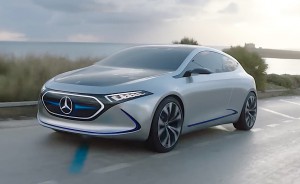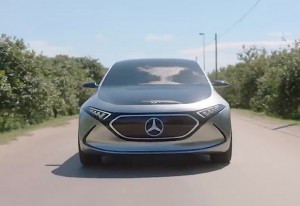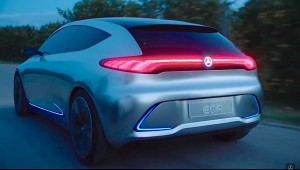
Mercedes-Benz EQA concept though still a year from production is clearly making plenty progress toward road-readiness.
While Mercedes is still a year away from introducing its all-new EQ battery-electric sub-brand, it’s giving a preview of what’s to come with these images of the Concept EQA sedan being driven through the Sicilian countryside.
A production version of this prototype, which made its debut at the Frankfurt Motor Show last autumn, will be part of a fast-growing line-up of long-range electric models, the EQC crossover set to launch the Mercedes-EQ brand-within-a-brand in 2019.
Parent Daimler AG is committing billions in its drive to electrify virtually its entire line-up, with everything from mild hybrids to pure battery-electric vehicles in the planning to pre-production stage. By 2022, the automaker has said, it wants to have 10 BEV models in the Mercedes line-up alone. Add various forms of hybrids and fuel-cell vehicles and there will be 60 electrified Mercedes models and variants available by then.
Add to that the Smart brand, as well, which is in the process of going 100% all-electric. Notably, the Smart plan in Hambach, France, will get a $589 million makeover to produce the EQC alongside the BEV version of the Smart fortwo.
(Mercedes tooling up French plant to taken on Tesla Model 3. Click Here for the story.)

The EQA is the first of the EQ electric vehicle sub-brand that Mercedes will roll out starting next year.
The EQA sedan will follow the EQC to market. And, from what Mercedes has already revealed, it’s expected to feature a pair of electric motors, one on each axle, creating a through-the-road all-wheel-drive system. Precise horsepower ratings haven’t been released, though combined torque is expected to come in somewhere under 400 pound-feet, enough to propel the sedan from 0 to 60 in around 5 seconds.
We’ve seen a variety of different battery pack numbers quoted, perhaps indicating plans to steal from the Tesla playbook and offer different options. The base package is expected to be around 60 kilowatt-hours, around what is fitted into the similarly-sized Chevrolet Bolt EV. That would likely yield a range of around 200 miles. There have been hints that the car could push it into 300 miles or more, much like the 90 kWh pack in the Tesla Model 3.
Charging times, meanwhile, using will likely run north of eight hours, with a 60 kWh pack, hooked up to a standard U.S. Level 2 240-volt charger. And wireless inductive charging will be offered. Plugged into one of the new Level 3, 480-volt systems rapidly popping up across the country, an 80% top-off is expected to take under 30 minutes. Daimler hasn’t said if the EQC and EQA will be equipped to use even more advanced charging systems soon to roll out. Rival BMW has previewed a system that, it claims, will deliver as much as 20 miles of range per minute.
(Click Here for more about the impact of AMG and Maybach on Mercedes sales.)
The EQA created plenty of buzz when it first debuted in Frankfurt, in part due to its distinctive design. That included a “virtual radiator grille” that would dramatically change their appearance, depending upon the driving mode. In Sport Plus, it resembled the vertical lines of the Mercedes Panamerica, while it switched to a wing-like look in Sport.
In a video showing the Concept EQA touring Sicily we also get a glimpse of what the automaker calls “illuminated arabesques” along the electric sedan’s rear haunches. There have been a few careful leaks from inside the tri-star brand suggesting at least some of the concept’s distinctive lighting details will carry over into production. Of course, one challenge is to avoid having them draw down range by sucking up a lot of power.
Along with the little EQA sedan and EQC crossover, Mercedes has confirmed plans for an electrified S-Class variant, the EQS. By 2025, the automaker has set a goal of having electrified vehicles account for as much as 25% of its line-up.
(For more abou the EQ platform, Click Here.)
The Chinese market, which recently laid out strict new mandates for zero-emission vehicles, is expected to take the lead, but demand is seen as growing fast in Europe, especially if markets like Britain and France follow Norway’s lead, the Scandinavian nation planning to phase out sales of gas and diesel models starting in mid-decade. Where the U.S. goes could depend on what happens with the Trump Administration’s plan to rollback the 54.5 mpg fuel economy standard currently set to take effect in 2025.

